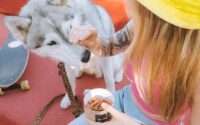15 Creative & Fun Games to Play with Your Dog
Welcoming a furry friend into your life means embracing moments filled with joy, laughter, and plenty of playtime. Whether you have a high-energy pup or a laid-back companion, finding new and exciting ways to entertain them is essential for their overall well-being. In this article, we’ll explore 15 creative and fun games to play with your dog that will not only keep them entertained but also strengthen your bond and stimulate their mind and body.
Why Playtime Matters
Playing with your dog isn’t just about having fun—it’s a crucial part of their physical and mental health. Here are a few reasons why playtime matters:
- Physical Exercise: Just like humans, dogs need regular exercise to stay healthy and maintain a healthy weight. Engaging in active games helps keep your dog’s muscles strong, improves cardiovascular health, and prevents obesity.
- Mental Stimulation: Dogs are intelligent creatures that thrive on mental stimulation. Playing games that challenge their problem-solving skills, memory, and senses can prevent boredom, reduce anxiety, and promote overall mental well-being.
- Bonding Opportunities: Playtime is an excellent opportunity to strengthen the bond between you and your dog. Through interactive games, you can build trust, communication, and mutual respect, fostering a deeper connection that lasts a lifetime.
Now that we understand the importance of playtime, let’s dive into 15 creative and fun games that will keep your dog entertained and fulfilled!
1. Fetch Variations
The classic game of fetch never gets old, but why stick to the traditional routine? Spice up your pup’s playtime with these fetch variations:
- Indoor Fetch: When outdoor space is limited, take the game indoors. Use soft toys or lightweight balls to prevent damage to furniture or valuables.
- Water Fetch: If your dog loves water, head to a nearby lake or beach for a refreshing game of water fetch. Just be sure to use a floating toy designed for water play.
- Nighttime Fetch: Extend playtime into the evening with glow-in-the-dark balls or toys. Not only does nighttime fetch add an extra element of fun, but it also helps burn off energy before bedtime.
2. Hide and Seek
Tap into your dog’s natural hunting instincts with a game of hide and seek. Here’s how to play:
- Hide and Treat: Hide small treats around the house or yard and encourage your dog to find them using their nose. Start with easy hiding spots and gradually increase the difficulty as your dog becomes more skilled.
- Hide and Seek with You: Take turns hiding and seeking with your dog. Start by hiding behind furniture or in another room and call your dog’s name to come find you. Reward them with praise and treats when they successfully locate you.
Playing hide and seek not only provides mental stimulation but also strengthens the bond between you and your furry friend. Ready or not, here we come!
3. Balloon Games
For a lighthearted and entertaining playtime experience, consider incorporating balloons into your dog’s routine. These colorful inflatables can add an element of excitement and unpredictability to your dog’s play sessions. Here are two balloon games to try:
- Chase and Pop: Blow up a few balloons and scatter them around the room or yard. Encourage your dog to chase and pop the balloons with their nose or paws. The popping sound and unpredictable movement of the balloons will captivate your dog’s attention and provide mental and physical stimulation.
- Balloon Fetch: Turn a game of fetch into a whimsical adventure by using balloons instead of traditional toys. Toss the balloon gently for your dog to retrieve, being mindful of their comfort level and any potential hazards. The lightweight and buoyant nature of balloons adds an element of fun and novelty to the game, keeping your dog engaged and entertained.
As with any playtime activity, supervise your dog closely to ensure their safety and remove any broken balloon pieces promptly. With these balloon games, you can add a playful twist to your dog’s day and create joyful moments together.
4. Tug-of-War
Tug-of-war is a classic game that allows your pup to unleash their inner strength while bonding with you. Here’s how to play it right:
- Choose the Right Toy: Opt for a sturdy rope toy specifically designed for tug-of-war. Avoid using clothing or other items that could be easily torn or ingested by your dog.
- Establish Rules: Teach your dog to release the toy on command to prevent possessiveness or aggression. Use phrases like “drop it” or “let go” and reward them with praise or treats when they comply.
Remember, tug-of-war should always be a friendly game between you and your dog. Avoid pulling too hard or allowing your dog to use their teeth aggressively to prevent injury.
5. Puzzle Toys and Treat Dispensers
Give your dog’s brain a workout with interactive puzzle toys and treat dispensers. Here’s why they’re a must-have for any playful pup:
- Stimulate Their Mind: Puzzle toys challenge your dog’s problem-solving skills and keep them mentally engaged. As they work to retrieve treats or toys from inside the puzzle, they’re exercising their brain and satisfying their natural curiosity.
- Prevent Boredom: Dogs can easily become bored when left alone for extended periods. Puzzle toys provide mental stimulation and entertainment, reducing boredom and preventing destructive behaviors like chewing or excessive barking.
Invest in a variety of puzzle toys and treat dispensers to keep your dog entertained and mentally sharp. They’ll thank you for the mental workout!
6. Obstacle Course
Create a mini agility course in your backyard or living room to challenge your dog’s agility and coordination. Here’s how to set it up:
- DIY Obstacles: Use household items like cones, hula hoops, and tunnels to create a makeshift obstacle course. Get creative with the layout and design to keep it exciting for your dog.
- Guide Your Pup: Lead your dog through the course using verbal cues and hand signals. Start with simple obstacles and gradually increase the difficulty as your dog becomes more confident.
An obstacle course not only provides physical exercise but also mental stimulation as your dog navigates through the various challenges.
7. Agility Training
Take your dog’s athleticism to the next level with formal agility training. Here’s why it’s beneficial:
- Build Confidence: Agility training builds your dog’s confidence as they conquer obstacles and master new skills. It’s a rewarding experience that boosts their self-esteem and strengthens the bond between you.
- Promote Fitness: Agility training is a full-body workout that improves your dog’s strength, endurance, and flexibility. It’s a fun way to keep them fit and healthy while burning off excess energy.
Enroll in a local agility class or set up your own agility course at home to enjoy the benefits of this exhilarating sport with your furry friend.
8. Nose Work
Tap into your dog’s incredible sense of smell with nose work games. Here’s how to get started:
- Hide and Seek: Hide treats or toys around the house and encourage your dog to use their nose to find them. Start with easy hiding spots and gradually increase the difficulty to keep it challenging.
- Scent Detection: Introduce scent detection games by hiding a specific scent, such as a cotton ball soaked in essential oil, and rewarding your dog for finding it. This activity engages their natural hunting instincts and provides mental stimulation.
Nose work games are not only fun but also provide an outlet for your dog’s innate abilities, keeping them mentally sharp and satisfied.
9. Flirt Pole
The flirt pole is a versatile toy that provides both physical and mental stimulation for your dog. Here’s why it’s a favorite among canine enthusiasts:
- Chase and Capture: The flirt pole mimics the movement of prey, encouraging your dog to chase and capture the lure attached to the end. It’s a great way to satisfy their natural hunting instincts in a safe and controlled environment.
- Builds Muscle Tone: Using the flirt pole helps build muscle tone and endurance in your dog’s body, promoting overall fitness and agility.
Whether you’re playing in the backyard or at the park, the flirt pole is sure to provide hours of fun and exercise for you and your furry friend.
10. DIY Snuffle Mat
Engage your dog’s sense of smell and natural foraging instincts with a DIY snuffle mat. Here’s how to create one:
- Materials Needed: Gather a rubber mat or baking tray and strips of fabric or fleece. Cut the fabric into small strips and tie them onto the mat or tray, creating a textured surface.
- Hide Treats: Sprinkle your dog’s favorite treats or kibble among the fabric strips, burying them within the folds. Encourage your dog to use their nose to search for the hidden goodies.
The snuffle mat provides mental stimulation and enrichment for your dog, turning snack time into a fun and rewarding activity.
11. Simon Says
Put your dog’s obedience skills to the test with a game of Simon Says. Here’s how to play:
- Give Commands: Take turns giving commands such as “sit,” “down,” or “spin.” Your dog must follow the command only when preceded by the phrase “Simon says.”
- Reward Correct Responses: Reward your dog with praise or treats for following the correct commands. This game reinforces obedience training and strengthens the bond between you and your dog.
Simon Says is a fun and interactive way to challenge your dog’s listening skills while reinforcing basic obedience commands.
12. Mind Games
Keep your dog’s mind sharp and engaged with a variety of mind games. Here are a few to try:
- Find the Toy: Hide your dog’s favorite toy and encourage them to find it using their sense of smell. Start with easy hiding spots and gradually increase the difficulty.
- Rotate Toys: Introduce new toys regularly and rotate them to keep your dog’s interest piqued. This prevents boredom and ensures that each play session remains exciting and enjoyable.
Mind games are a fun and effective way to provide mental stimulation and enrichment for your dog, keeping their brain engaged and satisfied.
13. Interactive Food Bowls
Turn mealtime into a fun and stimulating activity with interactive food bowls. Here’s how:
- Slow Feeder Bowls: Slow feeder bowls feature ridges and obstacles that require your dog to work for their food. This encourages slower eating, reduces bloating, and provides mental stimulation.
- Food Puzzle Bowls: Food puzzle bowls require your dog to manipulate moving parts or slide covers to access their food. These bowls challenge your dog’s problem-solving skills and keep them entertained during mealtime.
Interactive food bowls add an element of fun and enrichment to your dog’s daily routine, making mealtime more enjoyable and rewarding.
14. Agility Equipment at Home
Transform your backyard into an agility course with homemade equipment. Here’s how to set it up:
- Jump Bars: Use PVC pipes or wooden dowels to create jump bars at varying heights. Teach your dog to jump over the bars on command, starting with lower heights and gradually increasing as they progress.
- Weave Poles: Arrange a row of poles or cones for your dog to weave in and out of. Guide them through the poles using verbal cues and hand signals, rewarding them for each successful run.
Setting up agility equipment at home allows you to engage in this exciting activity with your dog, promoting fitness, agility, and bonding.
15. Water Games
If your furry friend loves to make a splash, water games are a fantastic way to keep them entertained and cool during the warmer months. Here are two refreshing options to try:
- Fetch in the Water: Head to a nearby lake, river, or dog-friendly beach and toss a floating toy into the water for your dog to retrieve. Whether it’s a tennis ball, frisbee, or buoyant stick, playing fetch in the water adds an exciting twist to this classic game and provides a full-body workout for your water-loving pup.
- Chase and Splash: If your dog enjoys a good swim, engage them in a game of chase and splash in shallow water. Run along the shoreline or wade into the water yourself, encouraging your dog to follow and playfully chase the waves. This exhilarating activity not only keeps them physically active but also allows them to indulge in their natural instinct to explore and interact with their aquatic surroundings.
Keep safety in mind by supervising your dog at all times, ensuring they’re comfortable in the water, and providing plenty of fresh water and breaks to prevent dehydration. With these water games, you and your canine companion can make a splash and create unforgettable memories together!
Conclusion
Playing games with your dog isn’t just about having fun—it’s an essential part of their physical and mental well-being. From traditional games like fetch to DIY obstacle courses and interactive food bowls, there are countless ways to keep your dog entertained and stimulated.
By incorporating these creative games into your dog’s routine, you’ll not only provide them with hours of enjoyment but also strengthen your bond and enhance their overall quality of life. So grab your pup’s favorite toy, head outdoors, and let the games begin!
Frequently Asked Questions
How important is playtime for dogs?
Playtime is crucial for dogs as it provides physical exercise, mental stimulation, and strengthens the bond between them and their owners.
What are the benefits of playing games with my dog?
Playing games with your dog promotes physical fitness, mental well-being, and provides an outlet for their natural instincts.
How often should I play games with my dog?
Aim for at least 30 minutes to an hour of playtime each day, but adjust based on your dog’s age, breed, and energy level.
Are there games suitable for senior dogs or dogs with mobility issues?
Yes, there are plenty of low-impact games and activities, such as gentle fetch or nose work, that are suitable for senior dogs or those with mobility issues.
Can I play games with my dog indoors?
Absolutely! Many games, such as hide and seek or indoor fetch, can be played indoors, providing entertainment regardless of the weather.
Are there games that help with training my dog?
Yes, games like hide and seek or puzzle toys can be used as training tools to reinforce obedience commands and stimulate your dog’s mind.
What if my dog doesn’t seem interested in playing games?
Try experimenting with different types of games and toys to find what your dog enjoys most. It’s also essential to consider your dog’s energy level and preferences.
Can playing games with my dog help with behavioral issues?
Yes, engaging in regular playtime can help reduce boredom, anxiety, and destructive behaviors by providing mental and physical stimulation.
Are there any safety considerations I should keep in mind while playing games with my dog?
Always supervise playtime to ensure the safety of both your dog and any toys or equipment used. Avoid games that could pose a choking hazard or cause injury.
How can I make playtime more enjoyable for my dog?
Incorporate a variety of games, toys, and activities to keep playtime exciting and engaging for your dog. Listen to their cues and adjust accordingly to ensure a positive experience.




